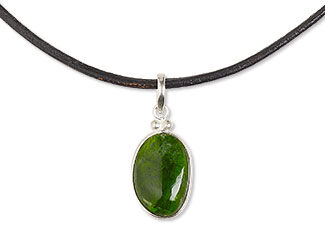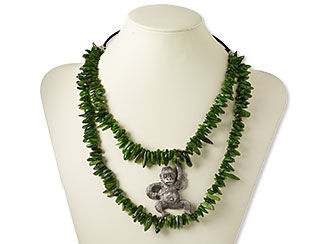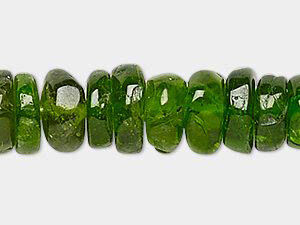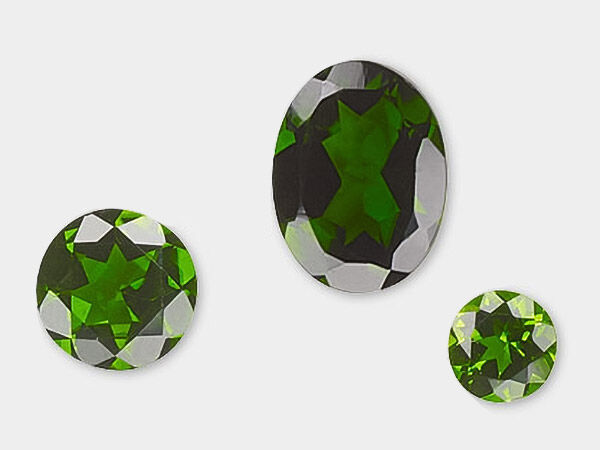Diopside, Chrome Meaning and Properties
Chrome Diopside History
Chrome diopside gemstones have been around a long time but were only officially discovered in 1988. Originally, chrome diopside was sourced from Russia's Eastern Siberia, but deposits have been found elsewhere in the world. Pakistan is now considered a significant supplier for gem-quality chromium diopside. Other locations of chrome diopside rough include Australia, Russia, Canada, Madagascar, Brazil and South Africa. Chrome diopside has been growing in popularity for jewelry due to its affordability and striking resemblance to more expensive gems such as emerald and tsavorite garnet.
The term diopside comes from the Greek words "di" and "opsis," which mean "two" and "vision." It's no surprise that ancient peoples viewed this stone as one of visualization, sometimes placing it on the forehead to help encourage good dreams. Other cultures believed green diopside had come from the tree of life. Many people buried their dead with the gemstone to ensure renewal of their life.
What are the Metaphysical Properties of Chrome Diopside?
Chrome diopside has long been used to boost creative vision and awareness. This green gemstone is also thought to be able to improve intellect and encourage the desire to learn. According to metaphysical beliefs, chrome diopside properties include helping alleviate aggression or stubbornness while in turn enhancing love and commitment.
Those who use gemstones for healing have been known to use chrome diopside in the treatment of headaches, to regulate blood pressure, to encourage recovery after illness and to help those who suffer from addiction. Chrome diopside is not a traditional birthstone, but it is associated with the Zodiac sign of Pisces as well as Gemini and Virgo.
What Chakra is Chrome Diopside?
Chakras are thought to be centers of energy that influence different aspects of our physical, emotional and spiritual well-being. The heart chakra, located at the center of the chest, is associated with love, compassion and emotional balance. Wearing chakra bracelets offers a simple and stylish way to keep supportive stones close, helping to enhance their energetic influence throughout the day. Green chrome diopside is linked to the heart chakra. Believed by some to encourage emotional openness, chrome diopside may help support healing from grief, deepen compassion and promote heartfelt connection with others.
Heart Chakra (Anahata) - Green
- Location: chest (breastbone)
- Represents: the union of male and female principles; ability to love
- Emotional issues: compassion; trust; forgiveness; compassion; complex emotions; tenderness; equilibrium; love
- Spiritual issues: devotion
- Physical issues: immune system; cardio-vascular system; lungs
- Gemstones: amazonite, aventurine, chrome diopside, jade, malachite, peridot, rhodonite, rhodochrosite, rose quartz
What is Chrome Diopside Made From?
Diopside is a monoclinic pyroxene mineral that occurs naturally in a variety of colors such as green, yellow and brown. Green is the most commonly found diopside color, which gets its beautiful hue from traces of the element chromium; hence the name chrome diopside. This chromium-rich diopside is transparent to translucent in appearance with a good chance of high visual clarity. The most valuable chromium diopside gems have a deep forest green similar to tsavorite garnet.
While chrome diopside is not difficult to come by, medium green stones over 2 carats are incredibly rare, as the larger the stone the darker it tends to be, even appearing nearly black. Chrome diopside does not receive enhancements to increase color or clarity, making it a naturally lovely untreated stone option for jewelry.
- Mineral Information: Calcium magnesium silicate
- Chemical Composition: CaMgSi2O6
- Color: Green, yellow, colorless, brown, black
- Hardness: 5 to 6 (Mohs)
- Specific Gravity: 3.22 – 3.38
- Refractive Index: 1.664 – 1.73
How Do You Clean Chrome Diopside?
Though chrome diopside is a favorite gemstone replacement for stones such as emerald, they are not nearly as hardy. Chrome diopside has a Mohs hardness of about 5 to 6 with a brittle tenacity and good cleavage. It's best to remove any chrome diopside jewelry before engaging in sports or other activity that could cause the stone to receive a sharp blow. Remove chrome diopside jewelry when using household cleaners (especially bleach) since the potentially harsh chemicals could cause adverse effects. Do not use ultrasonic or steam cleaners. The best method for cleaning chrome diopside is to use a mild soap and lukewarm water. Use a soft cloth to remove dust, fingerprints and other grime. Store chrome diopside gems and jewelry away from other gemstones and materials that could scratch the surface. Velveteen trays or soft pouches are best for storing chrome diopside jewelry.
Chrome Diopside FAQ
Q: Is chrome diopside components enhanced or treated?
A: Chrome diopside’s green luminescence is usually natural and untreated, although some specimens may be dyed to enhance the beautiful hue.
Q: What is the difference between chrome diopside and tsavorite garnet?
A: Chrome diopside and tsavorite garnet are chemically distinct gemstones with different physical properties. Tsavorite, a variety of green garnet, often displays brighter, more citrus-toned greens, while chrome diopside tends to exhibit deeper, forest-green hues. The most significant difference between the two is hardness: chrome diopside ranks 5 to 6 on the Mohs scale, making it more prone to scratching and wear, whereas tsavorite garnet is considerably harder, with a rating of 7 to 7-1/2—better suited for everyday jewelry.
Q: Is chrome diopside a good alternative to emerald?
A: Emerald and chrome diopside properties include a striking green hue, and as such, chrome diopside is often used in place of the more costly emerald when a design calls for a green gemstone.
Q: Is chrome diopside gaining popularity in jewelry designs?
A: Chrome diopside has gained popularity in jewelry for its rich green color and visual similarity to more costly gemstones like emerald and tsavorite garnet—offering a vivid alternative at a more accessible price point.
Designing with Chrome Diopside
The rich green of chrome diopside makes it an appealing gemstone to use in jewelry. Chrome diopside looks great alongside most metal tones but is predominately paired with silver or gold hues. If the chrome diopside is your main focus, try pairing it with clear cubic zirconia or other clear stones such as quartz. Chrome diopside is sometimes paired with pink gemstones such as tourmaline, purple gemstones like amethyst, lighter blue stones including aquamarine or even opals. For more monochromatic designs, peridot is a great choice, and lemon quartz or citrine provide a little added zest.
A Couple Design Ideas to Get You Started
Shop for Chrome Diopside
**Please note that all metaphysical or healing properties listed are collected from various sources. This information is offered as a service and not meant to treat medical conditions. Fire Mountain Gems and Beads® does not guarantee the validity of any of these statements.
How did you like this resource? Your feedback helps us provide resources that matter to you most.
Copyright Permissions
All works of authorship (articles, videos, tutorials and other creative works) are from the Fire Mountain Gems and Beads® Collection, and permission to copy is granted for non-commercial educational purposes only. All other reproduction requires written permission. For more information, please email copyrightpermission@firemtn.com.




